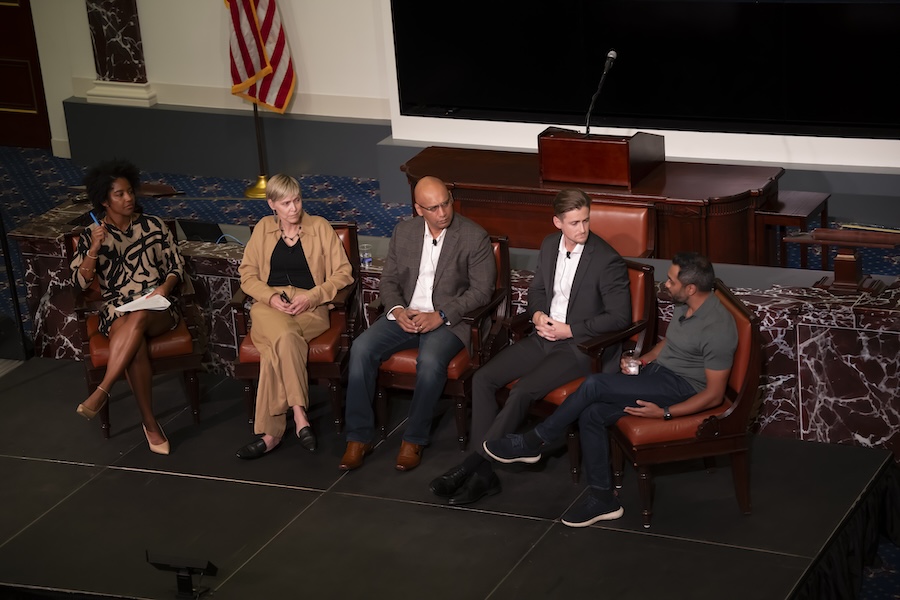Enhancing Holistic Well-Being With Comprehensive Benefits


There’s no universal solution for maintaining personal well-being, no matter your age, gender, background, or industry. During an executive panel at From Day One’s Boston conference, leaders shared how they prioritize their own well-being.
For Barb Short, senior director of corporate social responsibility and engagement at Sanofi, practicing Akashic soul reading is helpful for overall well-being. Aravind Menon, senior director, HR, at P&G practices meditation. Other panelists cited social media purges and having a healthy sleep schedule as helpful tips for maintaining wellness. The panelists shared their tips during a panel titled “Enhancing Holistic Well-Being With Comprehensive Benefits,” moderated by Paris Alston, co-host, Morning Edition, GBH News.
A holistic approach to well-being involves nurturing every aspect of an individual’s life, well-being benefits can foster a more holistically healthy workplace, leading to greater productivity, the panelists agreed.
From Balance to Integration
The idea of work-life balance is becoming outdated in discussions of well-being, as it suggests a constant equilibrium that isn’t always realistic. “We talk about integration, because work and life are not always evened out,” said Hem Patel, VP of total rewards at Moderna. “We do a lot of focus groups, surveys, and hearing [sessions] from people about what they value, particularly as your demographic evolves and changes. We’re continuously listening.”
Menon acknowledges that this dynamic is very culture-specific. “Asking someone with a family in the U.S. about what’s important will differ from what’s important for an Indian family in India,” he said. Where the U.S. is looking to prioritize things like surrogacy, adoption, and elder care, in India people are more concerned about getting help for their extended family. “What is a benefit for one might not count for the other. In Boston, we get free parking: it’s a huge benefit here,” he said.
Jon Harold, head of sales and partnership at SoFi advocates for financial management. “When the pandemic hit, there were a lot of employees with unexpected expenses, and they don’t often teach financial education in school,” he said. “A lot of employees are looking to employers for that guidance. It can come in coaching, like financial planners, personalized tools, credit score monitoring, or content like webinars and articles.”
For Short at Sanofi, the priority is building a culture of purpose. “I am working with my colleagues on that. We believe it is what creates a sense of belonging, and empathy that we all need,” she said.
Different Pieces of the Puzzle
Different needs emerge when you look at organizations that have more than a corporate workforce. At P&G, where 50,000 employees are manufacturers, there are a variety of needs unique to different work and lifestyles.“I was working at home, but a lot of folks were working on the line, and the big lesson there is that employees in manufacturing want work-life balance and flexibility. Their shifts are tough on the body, so they were asking for more flexibility,” said Menon. In response, the company restructured their shifts, and updated some of the factories, offering dining services, open areas, and even on-site gyms.

Moderna, having found itself evolving from a local company to a global leader in immunization, was coping with a lot of pressure. “[Employees] knew they were manufacturing a product that was saving lives, and every hour it did not happen, lives would be lost,” said Patel. “Having that level of stress is really something. Not long into the pandemic we introduced therapy sessions. We had parents working even longer shifts for the importance of what they were making.” Pride in the accomplishment had to be squared with the mental toll it was taking. “Biotech is a crowded space, so we wanted to make sure we were giving the best of the best in terms of benefits,” he said.
Leadership Modeling Behavior
Whether there is a lifestyle spending account, benefits offering tuition reimbursement, or coaching, leadership is always at the forefront. And there is often a learning curve involved. “People want to do good but at some point you have to tie rewards to that,” said Menon “We have to get employees to tell stories to our leaders: personal touch, being there, reward is what we primarily focus on.”
“Having them express themselves can bring them a long way,” said Short. “Compensation is not really what I hear about, what I hear about is the team they want to be on, who they want to work with,” she said. “We’re aiming to connect people across levels, geography, backgrounds, to ensure manufacturing and the corporate populations are all together.”
Angelica Frey is a writer and a translator based in Boston and Milan.
The From Day One Newsletter is a monthly roundup of articles, features, and editorials on innovative ways for companies to forge stronger relationships with their employees, customers, and communities.